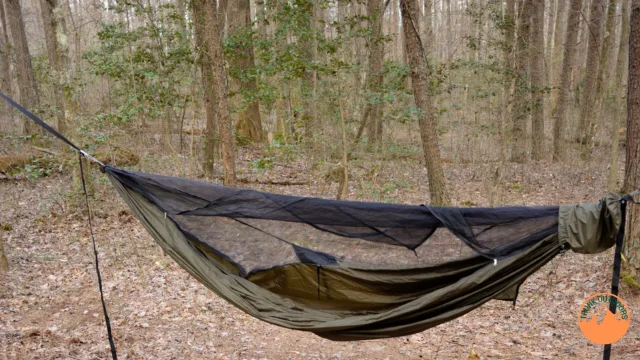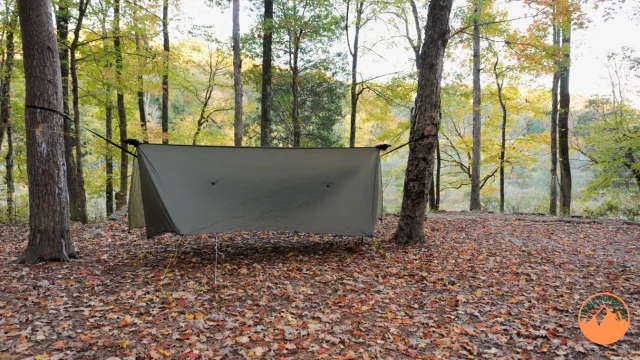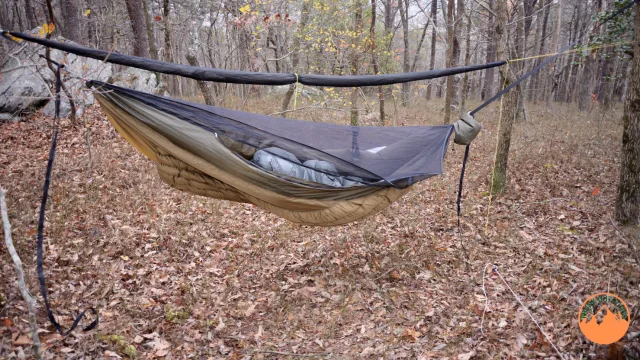Hammock Camping Must-Haves: 14 Essential Gear You Need
Hammock camping can be a great way to enjoy the outdoors. But it’s important to be prepared with the right gear.
By taking all of the hammock camping must-haves with you, you’ll be sure to have a comfortable and safe experience.
Remember, it’s better to be overprepared than underprepared.
Hammock camping essentials include:
- A suspension system
- A tarp
- A bug net
- An underquilt
- A top quilt
- Sleeping pad
- Camping gear like a backpack, cooking utensils, and food.
- A hammock itself.
This article will give you a more detailed look at each of the items listed above, and why they’re important. I’ll also share some tips on how to choose the right gear for your needs.
Keep reading!
hammock camping essentials
1. Hammock

The first and most obvious essential for hammock camping is, of course, a hammock.
There are many different types of camping hammocks available, but the most important factor to consider is the material.
Look for a hammock made from high-quality, durable materials that can withstand the elements and provide you with a comfortable place to sleep.
2. Hammock Straps
Once you have your hammock, you’ll need something to hang it from. This is where straps come in.
Straps are what you’ll use to attach your hammock to trees or other supports. Look for tree straps that are strong, durable, and adjustable.
This allows for a quick and easy hammock camping setup as well as the ability to make adjustments as needed.
Look for ones that are easy to use, adjustable, and able to support your weight, Check this 5 Best Hammock Tree Straps in 2023.
3. Hammock Tarps

While hammock camping is a great way to enjoy the outdoors, it’s important to be prepared for inclement weather.
A tarp is an essential piece of gear that can provide you with shelter from rain, wind, and other elements.
Choosing the right tarp for your hammock is crucial when it comes to ensuring a comfortable and safe outdoor experience. With so many options available in the market, it can be overwhelming to make the right choice.
The best tarp for your hammock depends on factors such as wind coverage, weight, and rain protection needed. It’s also important to ensure that the tarp extends over each end of your hammock, typically between 6 to 12 inches.
4. Sleeping Pads
Foam sleeping pads are must-have hammock accessories for insulation and padding in your hammock.
It adds an extra layer of warmth and comfort to camping hammocks, and helps to prevent cold air from seeping through the bottom of your hammock.
One common problem with using sleeping pads in hammocks is that they can shift around during use, causing discomfort and even slipping out of place entirely. This can be especially problematic for those who move around frequently in their sleep.
To combat this issue,we’ll provide you the following tips that can work well with you:
- Use a sleeping pad designed specifically for hammock use, which come with features such as wings or attachments to keep the pad in place.
- Use a double-layered hammock, which can help keep the pad from slipping out of place.
- Some hammock campers opt for underquilts instead of sleeping pads, which hang beneath the hammock and provide insulation without the need for a pad.
- Choose a sleeping pad that is appropriately sized for your hammock, as pads that are too large or small can cause discomfort and shifting.
Proper adjustment and positioning of your sleeping pad can make a significant difference in your comfort and quality of sleep while hammock camping.
5. Hammock Underquilt
Another challenge of hammock camping is staying warm. When you’re sleeping in a hammock, the air can circulate underneath you, which can make you cold. That’s where an underquilt comes in.
An underquilt is a layer of insulation that you hang underneath your hammock to keep you warm.
When choosing a hammock underquilt, there are several factors to consider.
- Firstly, consider the temperature rating of the underquilt to ensure that it is appropriate for the conditions you will be camping in. Many underquilts come with temperature ratings that correspond to specific temperature ranges, so be sure to choose one that suits your needs.
- Secondly, consider the size and shape of the underquilt to ensure that it is compatible with your hammock. Some underquilts may be designed specifically for certain types of hammocks or may come in different sizes to accommodate different hammock sizes.
- Additionally, consider the weight and packability of the underquilt, particularly if you will be backpacking or hiking to your camping location. Look for lightweight, compact options that won’t add too much bulk to your pack.
- Lastly, consider the material and insulation used in the underquilt. Synthetic insulation may be more affordable and durable, while down insulation may be more lightweight and packable. Choose the best one for your needs and budget.
Taking the time to carefully research and choose a high-quality hammock underquilt can make a significant difference in your comfort and warmth while hammock camping.
6. Top Quilt
In addition to an underquilt, you’ll also need a top quilt. A top quilt is a blanket that you’ll use to cover yourself while you sleep.
When choosing a top quilt, you should consider the following:
- Consider the temperature rating of the top quilt to ensure it is suitable for your camping conditions.
- Choose a size and shape that are compatible with your hammock.
- Look for a lightweight and compact option if you will be backpacking or hiking to your camping location.
- Consider the material and insulation used in the top quilt, such as synthetic or down insulation.
- Read reviews and compare options before making a purchase to ensure you are getting the best quality and value for your needs.
7. Hammock Bug Net

One of the downsides of camping in a hammock is the risk of being bitten by bugs. A bug net is an essential piece of gear that can protect you from mosquitoes, flies, and other pesky insects.
Look for a bug net that is easy to attach to your hammock and provides full coverage.
Attaching a bug net to a hammock can be done in several ways. Here are some steps to follow:
- Hang up your hammock and adjust it to the desired height.
- Place the bug net over the hammock, making sure it is centered and even.
- Secure the bug net to the hammock’s suspension system using clips, carabiners, or loops.
- Adjust the tension of the bug net to ensure it is taut and does not sag.
- If the bug net has a ridgeline, adjust it to the appropriate height and tie it off to the same anchor points as the hammock.
Remember to be careful not to damage the bug net during setup or takedown.
8. Headlamp
While a campfire is a great way to light up your campsite, you’ll also need a reliable source of light for nighttime activities.
A headlamp is an essential piece of gear that allows you to keep your hands free while still providing ample illumination.
Look for a headlamp that is lightweight, durable, and has a long battery life.
9. Water Filter
Staying hydrated is important during any outdoor adventure, and a water filter is an essential piece of gear that allows you to purify water from natural sources.
Here are some tips for choosing a good water filter for hammock camping:
- Choose a water filter that is lightweight and easy to pack
- Look for a filter that can handle a high volume of water
- Consider the type of filter, such as a pump filter or gravity filter, and choose one that fits your needs
- Research the water sources in your camping area to determine if a filter with a specific level of filtration is needed
- Check the filter’s lifespan and maintenance requirements to ensure it is practical for your trip
- Read reviews and compare options before making a purchase to ensure you are getting the best quality and value for your needs.
10. Portable Stove
If you plan on cooking during your hammock camping trip, a portable stove is an essential piece of gear.
Look for a stove that is lightweight, compact, and easy to use, and that runs on a fuel source that is readily available. Check these 10 Best Camping Stoves.
11. Food Storage
Proper food storage is essential for keeping your food fresh and safe from animals while camping. Choose a food storage container that is bear-proof and that seals tightly to keep your food fresh.
12. Cookware
Choose lightweight, durable cookware that is easy to pack and won’t take up too much space in your backpack. Look for cookware that is non-stick and easy to clean.
13. First Aid Kit
Accidents can happen during any outdoor adventure, and a first aid kit is an essential piece of gear that allows you to treat minor injuries and illnesses.
Look for a first aid kit that is comprehensive and includes items like bandages, antiseptics, and pain relievers.
14. Entertainment
When hammock camping, it’s important to have some form of entertainment to pass the time when you’re not exploring the wilderness or relaxing in your hammock, like:
- Books or E-reader
- Games and Playing Cards
- Musical Instruments
Related: Pros and Cons of Hammock Camping
FAQs
-
What is the best way to stay warm during cold nights when hammock camping?
The best way to stay warm during cold weather and nights when hammock camping is to use an underquilt and topquilt.
-
Can I use a regular sleeping bag in my hammock?
While it is possible to use a regular sleeping bag in your hammock, it may not provide the necessary insulation and padding.
It’s recommended to use a sleeping pad and underlayer of sleeping bags for added warmth and comfort. -
Can I hang my hammock anywhere?
No, it’s important to choose a sturdy and secure location to hang your hammock, such as between two trees or using a hammock stand.
-
Do I need a permit to hammock camp?
It depends on the location and regulations of the area you will be camping in. Check with the local authorities to see if a permit is required.
-
Is hammock camping safe?
Yes, it is safe if you have the right hammock camping gear and follow safety guidelines such as choosing a suitable camping location, correct hammock setup, and avoiding hazardous area
what do you need for hammock camping? Final Thoughts
Hammock camping is a fun and comfortable way to enjoy the great outdoors. With the right gear, you can stay dry, warm, and bug-free.
Whether you’re a beginner or an experienced hammock camper, these hammock camping essentials will help ensure a comfortable and enjoyable hammock camping experience.